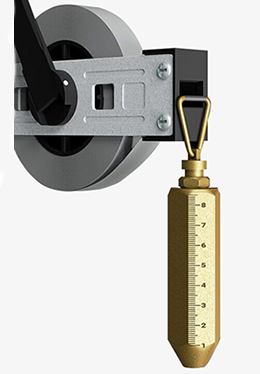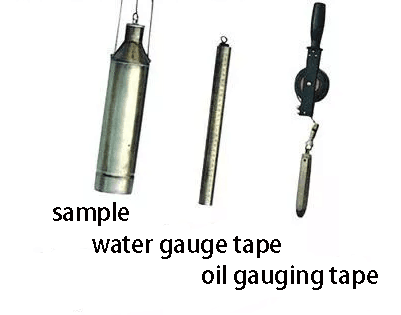Oil gauging tape is a key device used to measure the level of liquid oil and is widely used in various industrial, commercial, and scientific applications, including the petroleum industry, chemical industry, aerospace, marine, water treatment, petrochemicals, environmental monitoring, and more. Oil gauging tapes can be used with different working principles to meet different application requirements. sisco.com will take an in-depth look at the working principles and processes of oil gauging tape.
Common Working Principles of Oil Gauging Tape
- Float Oil Gauge Tape: The float oil gauging tape is a simple but effective tool for measuring oil levels. Its working principle is based on Archimedes' principle that the buoyancy of an object in a liquid is equal to the weight of the liquid it displaces. An oil measuring tape usually consists of a buoy and a scale. The buoy is immersed in the liquid and its position changes as the level changes, thus providing a reading of the level. This method is suitable for small vessels and tanks but is relatively inaccurate.

- Capacitive Oil Gauge Tape: The capacitive oil gauging tape uses the principle of capacitance to measure liquid level. It consists of two electrodes or capacitor plates, one located in the liquid and the other above the liquid. When the capacitance plate is located under the liquid level, its capacitance value changes because the presence of liquid affects the value of capacitance. By measuring the change in capacitance value, the liquid level height can be determined. This method provides highly accurate measurements for a variety of applications.
- Pressure Oil Gauge Tape: The pressure oil gauge uses the effect of liquid on pressure to measure liquid level. It includes a liquid density sensor and a pressure sensor. A rise or fall in liquid level causes a change in the output of the pressure sensor, which determines the liquid level height. This method is suitable for applications where changes in liquid density need to be taken into account, such as oil storage and refinery processes.
- Sonic Oil Gauge Tape: The sonic oil gauging tape uses an acoustic sensor to emit an acoustic signal and measure its return time. Acoustic waves travel at different speeds in liquids and air, so the level height can be determined by measuring the propagation time of the acoustic waves. This method provides highly accurate measurements for applications that require a high degree of accuracy, such as large storage tanks and chemical facilities.
- Microwave Oil Gauge Tape: The microwave oil gauging tape uses the propagation time of a microwave signal to determine liquid level height. A microwave signal is emitted from a sensor and reflected at the liquid level, then the sensor measures the time of the returned signal to determine the oil level. This method provides highly accurate measurements for applications that require high accuracy, such as petroleum refining and chemical processes.
Operating Process
Sensor Work: Oil gauging tape typically includes one or more sensors that are used to measure the liquid surface or oil level. Different types of sensors can work on different principles, such as capacitance, pressure, acoustic wave, microwave, etc.
Signal Transmission: The signals generated by the sensors are usually transmitted to a processing unit or controller for subsequent data processing and analysis.

Measuring Principle
Depending on the operating principle of the different sensors, the process of measuring the liquid level may vary.
- Capacitive Oil Gauging Tape: Capacitive oil gauging tapes utilize the principle of capacitance to measure the liquid level. The presence of liquid changes the capacitance value between the capacitor plates, and this change is proportional to the height of the liquid level.
Pressure-type oil gauging tape: Pressure-type oil gauging tape determines the liquid level by the pressure of the liquid. The rise or fall of the liquid level changes the pressure applied to the sensor, which measures the liquid level height. - Sonic Oil Gauge Tape: Sonic oil gauging tapes emit acoustic signals and measure their return time. Sound waves travel at different speeds in liquid and air, and the level height can be determined based on the echo time.
- Microwave Oil Gauges: Microwave oil gauging tapes use the propagation time of microwave signals to measure liquid level height. The microwave signal is emitted from the sensor and reflected at the liquid level, and then the sensor measures the return signal time.
Data Processing: The controller or processing unit typically receives the data generated by the sensor and processes it into a readable level height or level percentage. - Data Display and Output: The processed level data is typically displayed on the controller's screen or output via an electronic interface for user monitoring or logging. Some oil gauging tape can transmit data to a remote monitoring site via a wireless network.
Control operations: For some applications, oil gauging tape data can also be used to automate control operations, such as adjusting processes or valves to maintain desired fluid levels.
The process of operating an high precision oil gauging tape involves sensor data acquisition, data transmission, and processing, ultimately providing an accurate measurement of the liquid level height. Different types of oil gauging tapes use different operating principles to meet the requirements of different applications, including accuracy, environmental suitability, and real-time monitoring.

